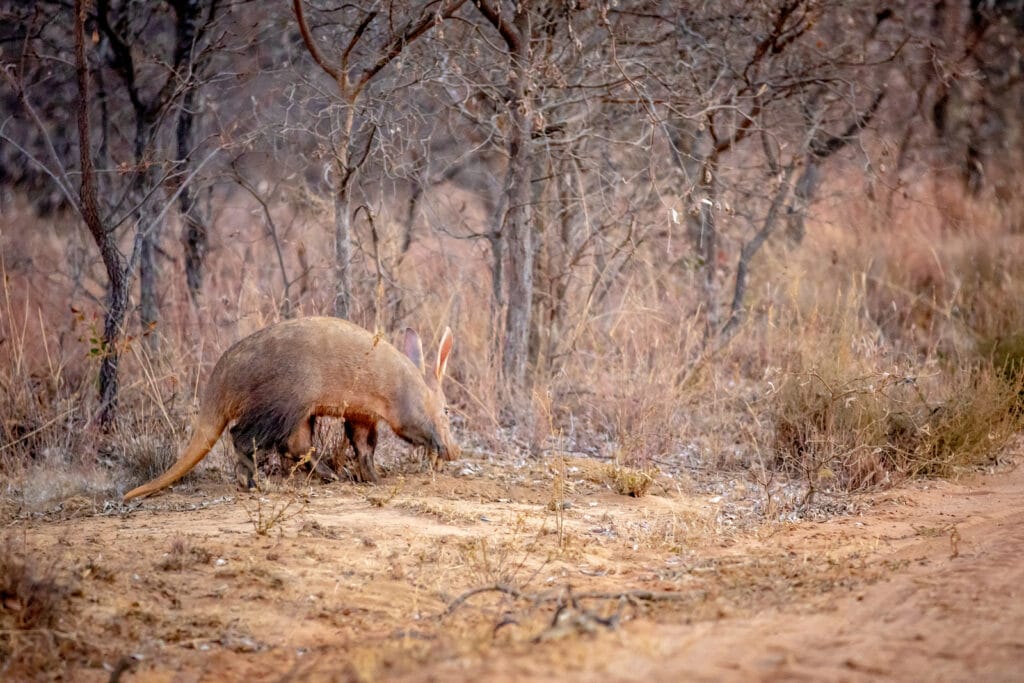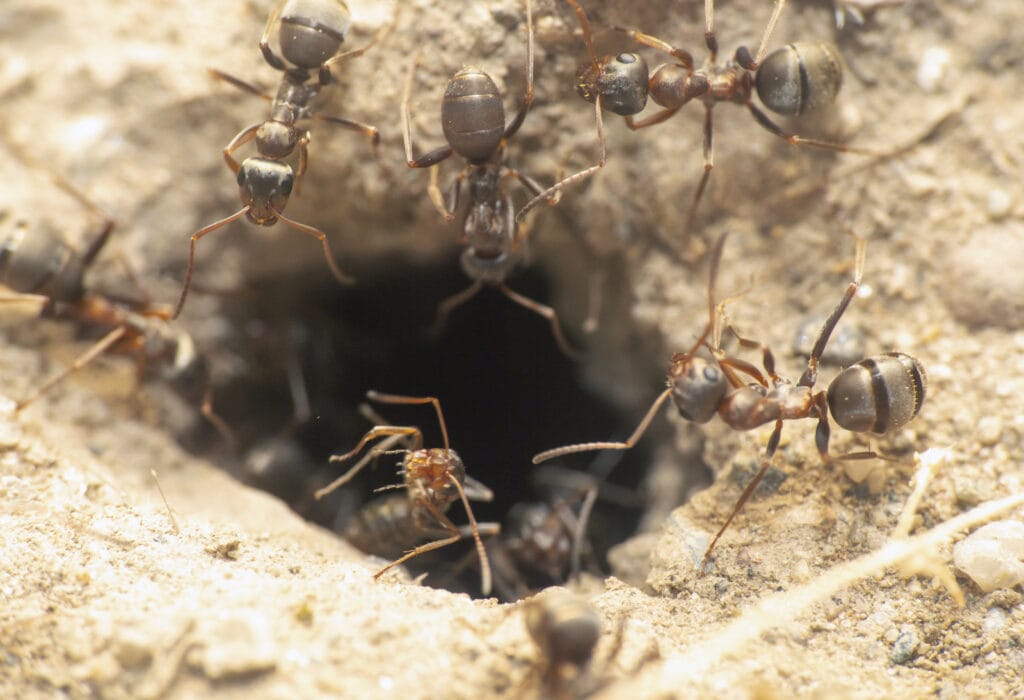The consequences of ants’ extinction only become clear by assessing the ecological role of ants in our tiny little universe.
Ants are a key part of the food chain. They’re a vital food source for many living creatures that prey on ants.
Besides, they perform certain fundamental natural tasks very few other creatures do.
Without ants fulfilling these natural duties, it would be catastrophic to the survival of humans, plants, and other creatures.
Ants are still pests. Some, like carpenter ants, are destructive.
Others, like the invasive imported red fire ants, sting us.
Black ants are a nuisance when they invade our food and living spaces.
While we understand the disadvantages of ants in our ecosystem, this article summarizes critical ant roles that would spell disaster for our planet with ants’ extinction.

Ants are a primary food source for many mammals, insects, and critters.
Ants play a crucial role in the food chain.
They are the primary diet for certain animals and a secondary protein source for many animals, insects, and birds.
Ants are a primary food source for the ant-eating family of animals, the Myrmecophagies mammals.
There are four extant species of anteaters in the Myrmecophagy family.
The forest-dwelling, small silky anteater (Cyclopes didactylus), the two species of tamandua, the semiarboreal vested/collared anteaters, and the predominantly terrestrial giant anteater (Myrmecophaga jubata).
All animals in this genus predominantly eat ants, with their diet approximately 90% comprised of ants.
The aardvark (Orycteropus afer) is another example of an ant-eating mammal not in the Myrmecophagy family.

They eat ants throughout the year and only hunt termites in winter when they cannot find ants.
The existence of the aardvark is already threatened by human expansion. Pangolins are also anteaters.
The extinction of ants would eliminate the main food source for the anteaters and the aardvark.
In addition to these ant-eating mammals, many other creatures feed on ants.
Lizards, birds, and some insect species rely on them for proteins.
Woodpeckers, in particular, eat more ants for proteins than most other birds.
Entomologists estimate that ants outnumber humans by about 1.5M to one.
Also, ants are not only populous but reproduce in large quantities, swiftly replenishing their colonies.
This large ant population ensures a constant supply of food to creatures that eat them without depletion.
The pitcher plant is a carnivorous plant that traps ants and then uses its juices to dissolve them for their protein.
Consequently, if ants were a food source to disappear, the food chain would be disrupted.
Some animal species would die, and many others would suffer.
Watch how much this bird loves ants.
References:
https://www.ncbi.nlm.nih.gov/pmc/articles/PMC5360932/
https://www.sciencedirect.com/science/article/abs/pii/S0140196301908547
Achieve soil aeration and enhance soil fertility
In crop production, water and air availability in the soil is vital.
Good distribution of oxygen and water occurs when soil is turned over mechanically or by forces of nature.
Ants are one of the forces of nature that meticulously turn the soil over, and how they do it is simply amazing.
Among the over 15,000 species of ants recorded, most make nests in the soil.
Some species dig tunnels up to 25 feet in depth.
Some studies estimate that, as ants dig new nests every few months, they turn over about 3.4 tons of soil, per hectare, per year.
This action translates to turning over 30cm of an old soil profile to a new one every 200 years.
Amazing!

According to research, further tests have revealed that soils around ant nests have more nutrients than those farther away from nests.
Plants growing on ant nest soils show greater biomass fitness than their counterparts.
Further, ants’ soil tunnels allow and accelerate water seepage into the soil for easy absorption by the plant roots.
Poorly aerated soils harbor soil-borne diseases.
Conclusively, ant nests positively influence soil fertility and vegetation health.
They ease the breakdown of organic matter and the absorption of nutrients back into the soil upon decaying.
No wonder ants are referred to as ecological engineers!
Extinction of ants would affect soil fertilization and health, aeration, humidity, and soil nutrient composition. Extinction would endanger cropping.
Plants’ health would suffer, and production would slow, impacting herbivores and humans.
References:
https://home.cyf-kr.edu.pl/~uxlaskow/ET_S800/Materialy/Ants_Folgarait_1998.pdf
https://doi.org/10.1073/pnas.2201550119
https://pubmed.ncbi.nlm.nih.gov/28369906/
Maintaining ecological balance
Ants maintain ecological balance in several ways. They are a major food source for many creatures.
Second, their digging action fundamental to soil fertility ensures plant growth and cropping. From this perspective, ants indirectly feed thousands of living organisms that depend on plants for food, including human beings.
It’s, therefore, factually sound to conclude that ants are a significant foundation of the food pyramid.
The other way ants maintain ecological balance is by keeping dangerous or harmful pests and creatures in check.
The usefulness of ants as biological pesticides is evident in some situations.
Some ant species prey on harmful arthropods and eat pests such as ticks and caterpillars.

Ecologically positive pest control is observed in shaded plants like mangoes, citrus trees, apples, and cocoa due to the presence of ants.
The result is improved plant productivity.
Termites like ants accelerate decomposition.
But they’re a huge threat to wood structures.
When termites attack wooden structures, the damages can run into hundreds if not thousands of dollars.
Effective chemical control of termites is very expensive, and some substances are toxic.
Most ants, though, prey on termites.
They eat them for their protein needs.
Doing so helps tame termite growth, which unchecked is a menace to timber and wood.
Here is a video of ants taking down a pack of termites!
References:
https://royalsocietypublishing.org/doi/10.1098/rspb.2022.1316#d1e1838
https://onlinelibrary.wiley.com/doi/full/10.1111/brv.12577
Ant Extinction, So What Would Happen?
Human activities and the indiscriminate use of chemical pest controls threaten the existence of some ants.
The disappearance of ants from the earth would affect all living creatures, including humans, animals, and plants.

Ant-eating mammals that exclusively feed on ants would go extinct.
Ants extinction would adversely affect soil health and fertility.
Ants turn over the soil, accelerate the decay of dead organisms and move rotting matter around. With less fertile soils, plants would yield less.
Many species of ants are biological pest controllers.
They destroy harmful pests that attack crops. By doing so, they maintain ecological balance.
These tiny creatures are the earth’s crucial component that helps us maintain a delicate balance in the functioning of our ecosystem.
Humans should, therefore, consciously undertake activities to foster the existence of ants.
Ant control measures or ant killer chemical substances should be adaptive, not aimlessly eliminate both useful and harmful ants.
